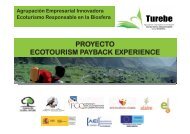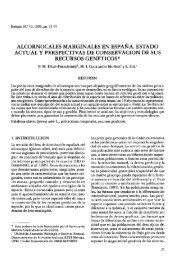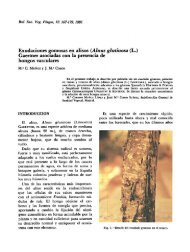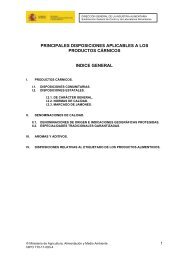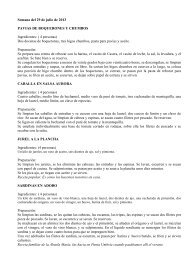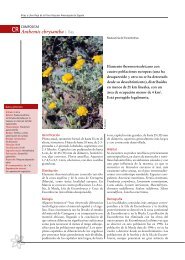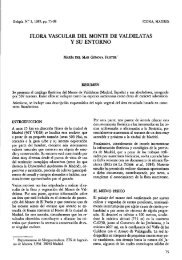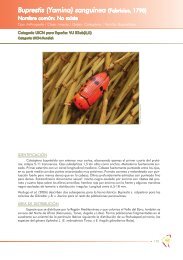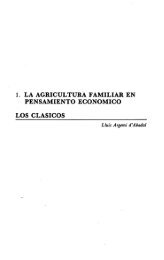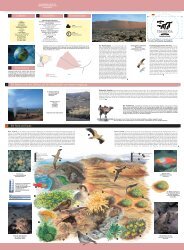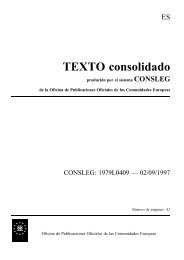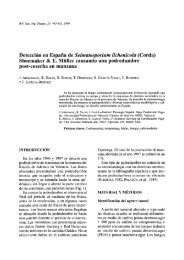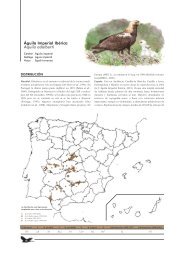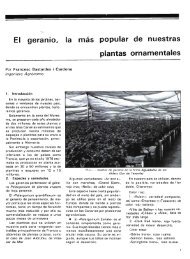Distribución espacial y asociación entre especies de acaros fitófagos
Distribución espacial y asociación entre especies de acaros fitófagos
Distribución espacial y asociación entre especies de acaros fitófagos
You also want an ePaper? Increase the reach of your titles
YUMPU automatically turns print PDFs into web optimized ePapers that Google loves.
encuentra en las flores mientras que la araña<br />
roja vive siempre en las hojas, por lo<br />
que la influencia <strong>entre</strong> ambas poblaciones<br />
no parece que pueda ser <strong>de</strong>cisiva.<br />
Otra forma <strong>de</strong> representar tanto la posible<br />
<strong>asociación</strong> <strong>entre</strong> <strong>especies</strong> <strong>de</strong>predadoras<br />
y fitófagas como la abundancia relativa <strong>de</strong><br />
las diversas <strong>especies</strong> es la que aparece en la<br />
Fig. 6. En dicha figura se muestra la probabilidad<br />
<strong>de</strong> que los tres artrópodos <strong>de</strong>predadores<br />
(A. californicus, Ph. persimilis y<br />
F. occi<strong>de</strong>ntalis) se encu<strong>entre</strong>n en hojas con<br />
y sin T. urticae (parte superior <strong>de</strong> la figura)<br />
y con y sin P. citri (parte inferior). Destaca<br />
la elevada probabilidad <strong>de</strong> encontrar a<br />
A. californicus en hojas con T. urticae (en<br />
el 46 % <strong>de</strong> las hojas con araña roja apareció<br />
también este fitoseido mientras que sólo<br />
se encontró en el 7 % <strong>de</strong> las hojas en que<br />
no había araña roja).<br />
Ph. persimilis muestra una pauta parecida,<br />
aunque las proporciones son inferiores<br />
por ser mucho menos abundante: se encuentra<br />
aproximadamente en el 16 % <strong>de</strong><br />
hojas con T. urticae, frente al 2 % <strong>de</strong> las<br />
hojas en que no existe esta presa. Con<br />
F. occi<strong>de</strong>ntalis las probabilida<strong>de</strong>s están más<br />
igualadas en ambos casos.<br />
ABSTRACT<br />
En el caso <strong>de</strong> P. citri las probabilida<strong>de</strong>s<br />
<strong>de</strong> encontrar a los <strong>de</strong>predadores en hojas<br />
con o sin fitófago son aproximadamente las<br />
mismas, lo que confirma la ausencia <strong>de</strong> relación<br />
ya encontrada con los índices <strong>de</strong> <strong>asociación</strong>.<br />
AGRADECIMIENTOS<br />
F. GARCÍA MARI; J. E. GONZÁLEZ ZAMORA; S. ORENGA ROYO; J. SAQUES FER-<br />
NÁNDEZ; R. LABORDA CENJOR; A. SOTO SÁNCHEZ y A. RIBES KONINCKX, 1991: <strong>Distribución</strong><br />
<strong>espacial</strong> y <strong>asociación</strong> <strong>entre</strong> <strong>especies</strong> <strong>de</strong> ácaros <strong>fitófagos</strong> (Tetranychidae) y <strong>de</strong>predadores<br />
(Phytoseiidae) en hojas <strong>de</strong> fresón. Bol. San. Veg. Plagas: 17 (3): 401-405.<br />
A study has been ma<strong>de</strong> on the i<strong>de</strong>ntity, aggregation patterns and association between<br />
mite species living on the leaves in five strawberries orchards from La Ribera<br />
Alta (Valencia). The main species i<strong>de</strong>ntified were the phytophagous Tetranychus urticae<br />
Koch and the predator Amblyseius californicus (McGregor). Panonychus citri<br />
(McGregor) has also been found on strawberry orchards located near citrus plantations,<br />
and Phytoseiulus persimilis Athias-Henriot was recovered after being released<br />
from artificial rearing units. Most of the phytophagous population were eggs, whereas<br />
most of the predator forms were motile forms. The estimatios of the aggregation patterns<br />
on the leaves by means of the in<strong>de</strong>x of Taylor shows that T. urticae populations<br />
are the most clumped (b = 1,62 ± 0,05), being the other three mite species slighty<br />
less aggregated, with «b» values ranging from 1,43 to 1,49 for all the <strong>de</strong>veloping stages.<br />
Within each species, eggs and immatures appear always more clumped than adult<br />
females. The association on the leaves between phytophagous and predatory species<br />
was <strong>de</strong>tected and calculated using four association indices. A positive association was<br />
found between T. urticae and the three predatory species i<strong>de</strong>ntified, A. californicus,<br />
Ph. persimilis and Frankliniella occi<strong>de</strong>ntalis Pergan<strong>de</strong> (Thysanoptera, Thripidae). On<br />
the contrary, the association between P. citri and the predators were low or lacking.<br />
Key words: Dispersion, association, Tetranychids, Phytoseids, strawberry.<br />
Este proyecto se ha realizado gracias al<br />
apoyo económico <strong>de</strong> la Comisión Interministerial<br />
<strong>de</strong> Ciencia y Tecnología (CICYT)<br />
en su proyecto AGR88-0175 y <strong>de</strong>l Servicio<br />
<strong>de</strong> Protección <strong>de</strong> Vegetales <strong>de</strong> la Consellería<br />
<strong>de</strong> Agricultura y Pesca <strong>de</strong> la Generalitat<br />
Valenciana. Asimismo agra<strong>de</strong>cemos la<br />
beca concedida por la Consellería <strong>de</strong> Cultura,<br />
Educación y Ciencia <strong>de</strong> la Generalitat<br />
Valenciana al segundo autor. Deseamos<br />
expresar también nuestro agra<strong>de</strong>cimiento a<br />
la Cooperativa Agrícola <strong>de</strong> Alginet y en<br />
particular a su técnico D. Salvador García<br />
por la cesión <strong>de</strong> una <strong>de</strong> sus parcelas <strong>de</strong> ensayo<br />
y por el apoyo obtenido y por último<br />
a los Sres. Espert, Zurriaga (padre e hijo)<br />
y Quijal por la confianza <strong>de</strong>mostrada al ce<strong>de</strong>rnos<br />
una parte <strong>de</strong> sus parcelas.



